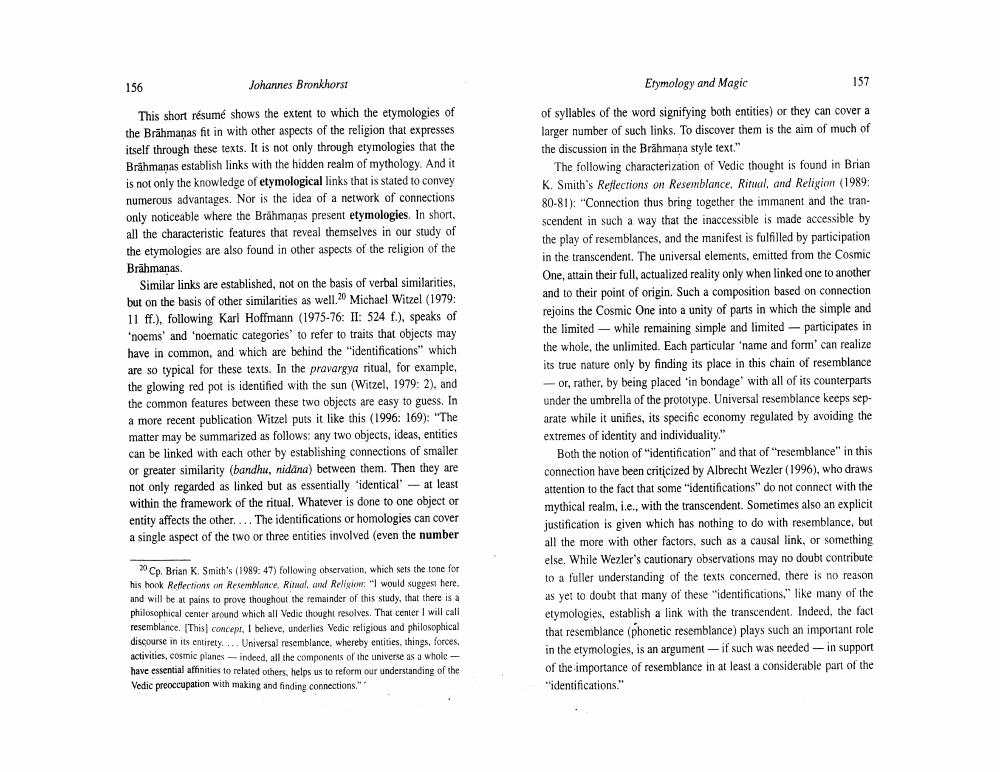Book Title: Etymology And Magic Yaskas Nirukta Flatos Cratylus And Riddle Of Semanticetymologies Author(s): Johannes Bronkhorst Publisher: Johannes Bronkhorst View full book textPage 6
________________ 156 Johannes Bronkhorst Etymology and Magic 157 This short résumé shows the extent to which the etymologies of the Brahmanas fit in with other aspects of the religion that expresses itself through these texts. It is not only through etymologies that the Brahmanas establish links with the hidden realm of mythology. And it is not only the knowledge of etymological links that is stated to convey numerous advantages. Nor is the idea of a network of connections only noticeable where the Brāhmanas present etymologies. In short, all the characteristic features that reveal themselves in our study of the etymologies are also found in other aspects of the religion of the Brahmanas. Similar links are established, not on the basis of verbal similarities, but on the basis of other similarities as well. Michael Witzel (1979: 11 ff.), following Karl Hoffmann (1975-76: II: 524 f.), speaks of 'noems' and 'noematic categories' to refer to traits that objects may have in common, and which are behind the "identifications" which are so typical for these texts. In the pravargya ritual, for example, the glowing red pot is identified with the sun (Witzel, 1979: 2), and the common features between these two objects are easy to guess. In a more recent publication Witzel puts it like this (1996: 169): "The matter may be summarized as follows: any two objects, ideas, entities can be linked with each other by establishing connections of smaller or greater similarity (bandhu, nidana) between them. Then they are not only regarded as linked but as essentially identical - at least within the framework of the ritual. Whatever is done to one object or entity affects the other. ... The identifications or homologies can cover a single aspect of the two or three entities involved (even the number of syllables of the word signifying both entities) or they can cover a larger number of such links. To discover them is the aim of much of the discussion in the Brahmana style text." The following characterization of Vedic thought is found in Brian K. Smith's Reflections on Resemblance, Ritual, and Religion (1989: 80-81): "Connection thus bring together the immanent and the transcendent in such a way that the inaccessible is made accessible by the play of resemblances, and the manifest is fulfilled by participation in the transcendent. The universal elements, emitted from the Cosmic One, attain their full, actualized reality only when linked one to another and to their point of origin. Such a composition based on connection rejoins the Cosmic One into a unity of parts in which the simple and the limited - while remaining simple and limited - participates in the whole, the unlimited. Each particular 'name and form' can realize its true nature only by finding its place in this chain of resemblance - or, rather, by being placed in bondage with all of its counterparts under the umbrella of the prototype. Universal resemblance keeps sep. arate while it unifies, its specific economy regulated by avoiding the extremes of identity and individuality." Both the notion of "identification" and that of "resemblance" in this connection have been criticized by Albrecht Wezler (1996), who draws attention to the fact that some "identifications" do not connect with the mythical realm, i.e., with the transcendent. Sometimes also an explicit justification is given which has nothing to do with resemblance, but all the more with other factors, such as a causal link, or something else. While Wezler's cautionary observations may no doubt contribute to a fuller understanding of the texts concerned, there is no reason as yet to doubt that many of these "identifications." like many of the etymologies, establish a link with the transcendent. Indeed, the fact that resemblance (phonetic resemblance) plays such an important role in the etymologies, is an argument - if such was needed in support of the importance of resemblance in at least a considerable part of the "identifications." * Cp. Brian K. Smith's (1989: 47) following observation, which sets the tone for his hook Reflections on Resemblance. Rimal, and Religion: "I would suggest here. and will be at pains to prove thoughout the remainder of this study, that there is a philosophical center around which all Vedic thought resolves. That center will call resemblance. This concept, I believe, underlies Vedic religious and philosophical discourse in its entirely.... Universal resemblance, whereby entities, things, forces, activities, cosmic planes - indeed, all the components of the universe as a wholc - have essential affinities to related others, helps us to reform our understanding of the Vedic preoccupation with making and finding connections."Page Navigation
1 ... 4 5 6 7 8 9 10 11 12 13 14 15 16 17 18 19 20 21 22 23 24 25 26 27 28 29
